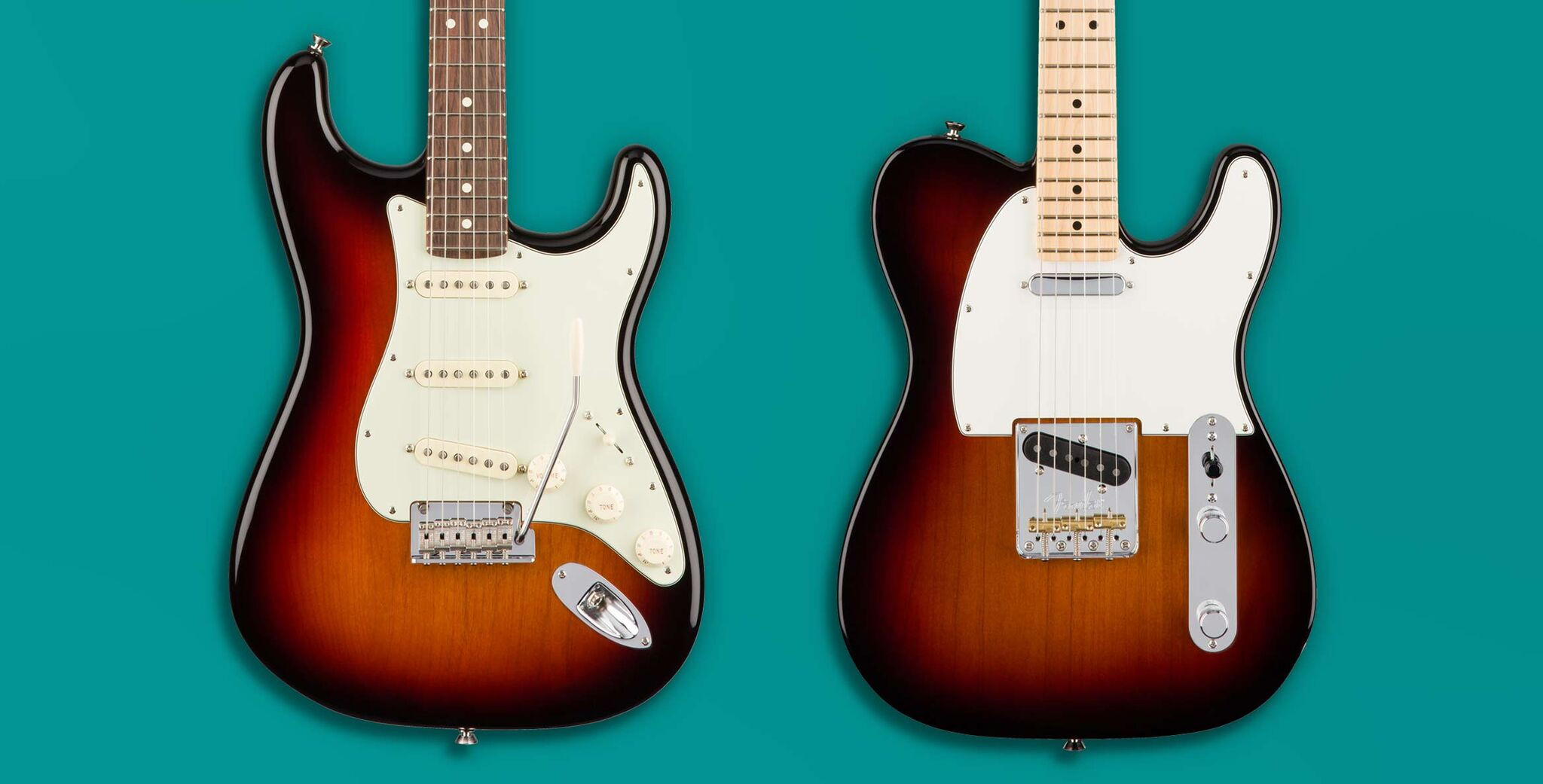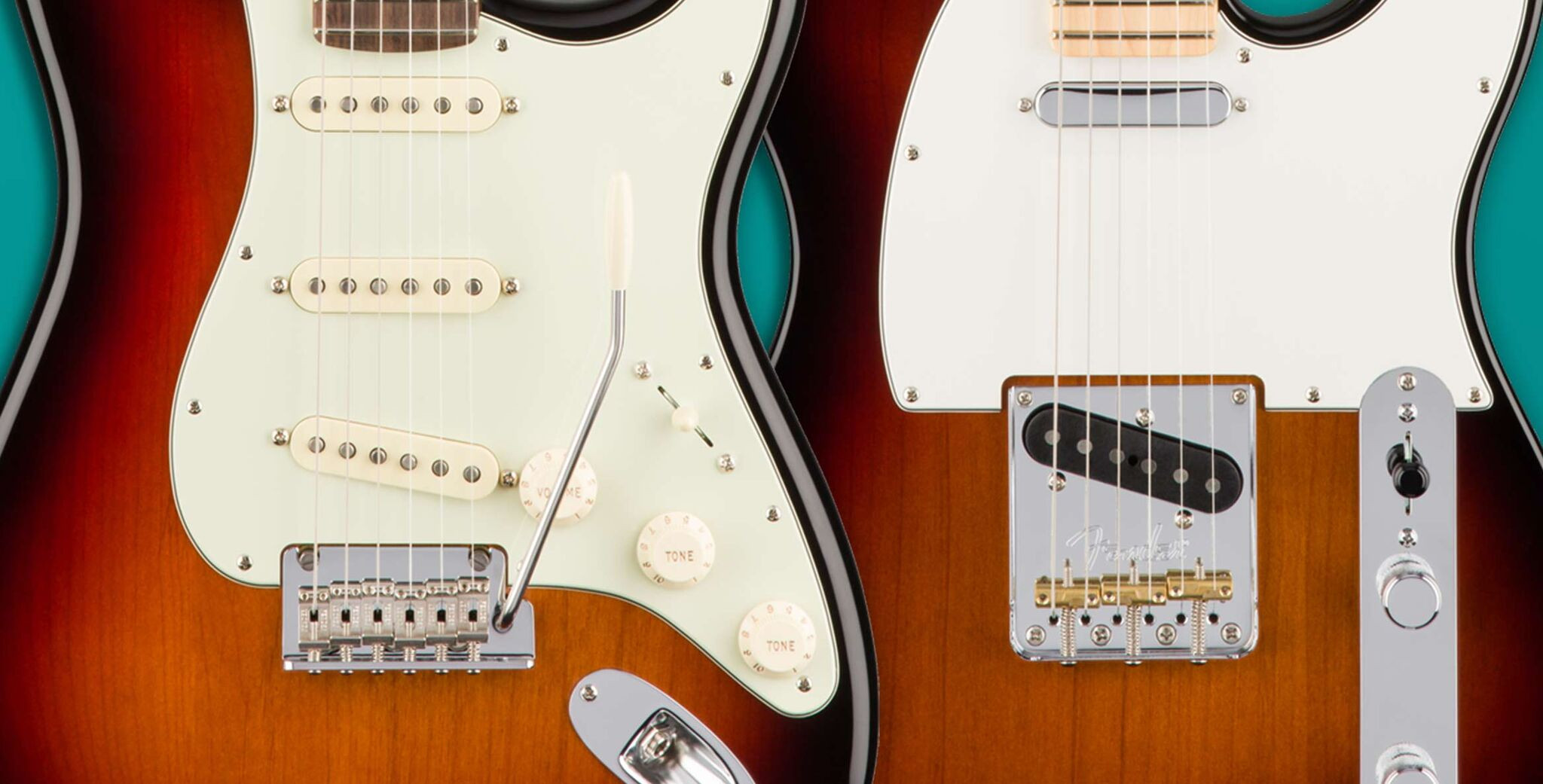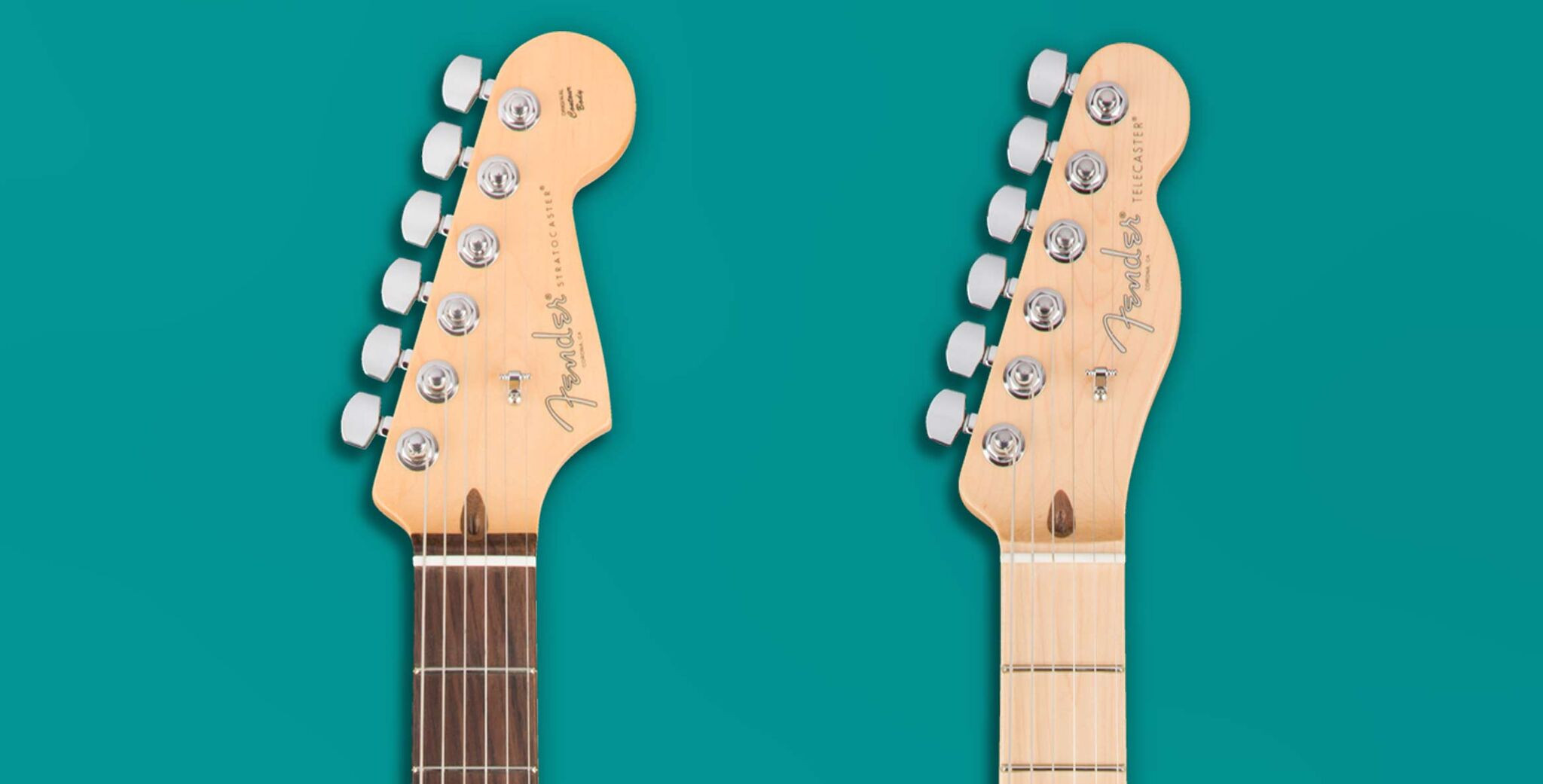The Tele guitar, also known as the Telecaster, is a legendary electric guitar renowned for its bright tone, simple design, and versatility, making it a favorite among guitar players across genres and skill levels; discover more at guitarplayers.net. This iconic instrument has shaped the sound of music for decades, with its influence deeply rooted in country, rock, blues, and beyond, solidifying its place as a foundational instrument in popular music and a symbol of guitar craftsmanship. Explore Telecaster history, design elements, and tonal capabilities.
1. What Defines a Tele Guitar?
A Tele guitar, short for Telecaster, is defined by its distinct single-cutaway body, bolt-on neck, and two single-coil pickups, delivering a bright, twangy tone ideal for a wide range of musical genres. The Telecaster stands as a pioneering solid-body electric guitar. Its straightforward design and clear, articulate sound have made it a staple for guitarists in country, blues, rock, and more. The Telecaster’s design incorporates a simple yet effective control layout, typically featuring a three-way pickup selector switch, a master volume knob, and a master tone knob. This setup allows players to easily dial in their desired sound, from clean and crisp to gritty and overdriven.
1.1. What are the key features of a Telecaster?
The key features of a Telecaster include its ash or alder body, maple neck, single-coil pickups, and a bridge with adjustable saddles, resulting in a bright, resonant, and highly playable guitar.
- Body: Typically made of ash or alder, contributing to its bright and balanced tone.
- Neck: Usually maple, bolted on for a snappy response.
- Pickups: Two single-coil pickups delivering a clear, articulate sound.
- Bridge: Features adjustable saddles for precise intonation.
1.2. What is the history of the Telecaster?
The Telecaster has a rich history, originating in the early 1950s as the first mass-produced solid-body electric guitar, revolutionizing music and guitar manufacturing; according to Fender’s official history, its innovative design quickly made it a favorite among musicians. Introduced by Leo Fender in 1951, originally as the “Esquire” and then the “Broadcaster,” it quickly became a staple due to its revolutionary design and sound. Facing a trademark conflict, Fender renamed it the “Telecaster” in 1952, solidifying its place in history.
1.3. What are the different types of Telecasters available?
The different types of Telecasters available range from vintage reissues to modern variations with different pickup configurations, body woods, and hardware options, catering to diverse playing styles and tonal preferences.
- Vintage Reissues: Accurate recreations of classic Telecasters from the 1950s and 1960s, offering vintage specs and tones.
- Modern Telecasters: Incorporate modern features like hotter pickups, different neck profiles, and updated hardware for enhanced playability and versatility.
- Deluxe Telecasters: Offer premium features such as binding, custom pickups, and upgraded electronics for a more refined playing experience.
- Thinline Telecasters: Semi-hollow bodies provide a lighter weight and more resonant tone.
- Custom Telecasters: Allow players to personalize their instrument with custom finishes, pickups, and hardware to meet their specific needs.
2. Why Is the Telecaster So Popular?
The Telecaster’s enduring popularity stems from its simplicity, reliability, and versatile sound, making it a favorite among guitarists across genres, as noted by Guitar World; its affordability and ease of modification also add to its appeal. The Telecaster is renowned for its ability to deliver a wide range of tones, from bright and twangy country sounds to aggressive rock riffs. Its straightforward design makes it easy to maintain and modify, appealing to both beginners and experienced players.
2.1. What makes the Telecaster a versatile guitar?
The Telecaster is a versatile guitar because of its clear, articulate pickups, simple controls, and ability to adapt to various musical styles, from country and blues to rock and jazz. Its adaptability is further enhanced by the wide variety of aftermarket parts available, allowing players to customize their Telecaster to suit their specific needs.
2.2. How does the Telecaster compare to other electric guitars?
The Telecaster compares to other electric guitars, such as the Stratocaster, with its brighter tone, simpler design, and more direct signal path, making it a favorite for players seeking a raw and immediate sound.
| Feature | Telecaster | Stratocaster |
|---|---|---|
| Tone | Bright, twangy, direct | Rounder, more complex, versatile |
| Design | Simple, single-cutaway | Contoured body, double-cutaway |
| Pickups | Two single-coil | Three single-coil |
| Bridge | Fixed bridge, often with a metal plate | Tremolo system, allowing for pitch bending |
| Common Genres | Country, rock, blues | Rock, blues, pop |
| Notable Players | Keith Richards, Brad Paisley, James Burton | Jimi Hendrix, Eric Clapton, David Gilmour |
2.3. What are the advantages of playing a Telecaster?
The advantages of playing a Telecaster include its reliability, bright tone, comfortable neck, and ease of modification, making it a great choice for both beginners and professional guitarists; guitarplayers.net offers guides on maximizing these advantages. Its simple design and robust construction make it a workhorse instrument that can withstand the rigors of touring and recording.
3. How Does the Design of a Telecaster Affect Its Sound?
The design of a Telecaster significantly affects its sound through its solid body, bolt-on neck, and single-coil pickups, which contribute to its bright, clear, and resonant tone, according to experts at Berklee College of Music. The Telecaster’s design focuses on simplicity and functionality. The solid body provides excellent sustain and minimizes unwanted feedback. The bolt-on neck contributes to the guitar’s snappy response and clear articulation.
3.1. How do the pickups contribute to the Telecaster sound?
The pickups contribute to the Telecaster sound by delivering a bright, clear, and twangy tone, with the bridge pickup providing a biting, aggressive sound and the neck pickup offering a warmer, more rounded tone.
- Bridge Pickup: Delivers a bright, biting tone ideal for country twang and rock riffs.
- Neck Pickup: Offers a warmer, rounder tone suitable for blues and jazz.
- Pickup Placement: The positioning of the pickups contributes to the unique tonal characteristics of each pickup.
- Single-Coil Design: Provides a clear, articulate sound with plenty of high-end detail.
3.2. What is the role of the body wood in the Telecaster’s tone?
The role of the body wood in the Telecaster’s tone is significant, with ash providing a bright, resonant tone and alder offering a balanced, warm sound, allowing players to choose based on their tonal preferences.
- Ash: Known for its bright, resonant tone with strong sustain.
- Alder: Provides a balanced, warm sound with good clarity.
- Mahogany: Offers a warmer, richer tone with enhanced sustain.
- Pine: Delivers a lightweight, resonant tone with a vintage character.
3.3. How does the bridge design impact the Telecaster’s sound?
The bridge design impacts the Telecaster’s sound by providing a direct connection between the strings and the body, enhancing sustain and contributing to its characteristic twang, particularly with the traditional bridge plate.
- Traditional Bridge: Features a metal plate that enhances sustain and contributes to the Telecaster’s twang.
- Modern Bridge: Offers improved intonation and adjustability while maintaining the Telecaster’s core tone.
- String-Through-Body Design: Increases sustain and resonance by passing the strings through the body.
- Saddle Material: Affects the guitar’s tone, with brass saddles providing a warmer sound and steel saddles offering a brighter sound.
 Telecaster Body
Telecaster Body
4. How to Choose the Right Telecaster for You?
To choose the right Telecaster, consider your budget, playing style, and preferred tone, and explore different models and pickup configurations to find the best fit; guitarplayers.net offers comprehensive reviews and comparisons to aid in your decision. It’s important to play different Telecasters and listen carefully to their sound. Pay attention to the neck profile, body weight, and overall feel of the guitar. Consider your favorite guitarists and the type of Telecasters they play.
4.1. What are the key factors to consider when buying a Telecaster?
Key factors to consider when buying a Telecaster include the body wood, neck profile, pickups, bridge type, and overall playability, ensuring the guitar matches your tonal preferences and playing style.
- Body Wood: Choose between ash, alder, or other woods based on your desired tone.
- Neck Profile: Select a neck shape that feels comfortable in your hand, such as a C-shape, V-shape, or U-shape.
- Pickups: Decide on single-coil, humbucker, or a combination based on your preferred sound.
- Bridge Type: Opt for a traditional bridge for classic twang or a modern bridge for improved intonation.
- Playability: Ensure the guitar feels comfortable to play, with easy access to all frets and smooth action.
4.2. How does the price range affect the quality of a Telecaster?
The price range affects the quality of a Telecaster, with higher-priced models typically featuring better materials, craftsmanship, and components, resulting in improved tone, playability, and durability; guitarplayers.net provides detailed guides on value at different price points.
| Price Range | Quality Indicators |
|---|---|
| Under $500 | Entry-level materials, basic hardware, suitable for beginners |
| $500 – $1000 | Improved wood quality, better pickups, enhanced playability |
| $1000 – $2000 | High-quality tonewoods, premium pickups, professional-grade hardware |
| Over $2000 | Boutique-level craftsmanship, custom options, exceptional tone and playability |
4.3. What are some popular Telecaster models for different skill levels?
Some popular Telecaster models for different skill levels include the Squier Affinity Series for beginners, the Fender Player Series for intermediate players, and the Fender American Professional II Series for advanced players.
- Beginner: Squier Affinity Series Telecaster – Affordable and easy to play, perfect for beginners.
- Intermediate: Fender Player Series Telecaster – Offers improved components and playability for developing players.
- Advanced: Fender American Professional II Series Telecaster – Provides premium features and exceptional tone for experienced guitarists.
- Professional: Fender Custom Shop Telecaster – Hand-crafted with the finest materials for ultimate performance.
 Telecaster Electronics
Telecaster Electronics
5. Who Are Some Famous Telecaster Players?
Famous Telecaster players include iconic musicians like Keith Richards, whose raw rock sound is synonymous with the Telecaster, and Brad Paisley, known for his country twang; guitarplayers.net features articles on these and other influential players. Many guitarists have favored the Telecaster for its distinctive sound and versatility.
5.1. Who are some notable Telecaster players in country music?
Notable Telecaster players in country music include Brad Paisley, known for his intricate guitar work, and Vince Gill, celebrated for his soulful playing, both of whom have shaped the genre with their Telecaster tones.
- Brad Paisley: Renowned for his modern country sound and exceptional Telecaster skills.
- Vince Gill: Celebrated for his smooth vocals and soulful Telecaster playing.
- James Burton: A legendary guitarist known for his work with Elvis Presley and his influential Telecaster style.
- Roy Buchanan: A master of tone and emotion, known for his expressive Telecaster playing.
5.2. Who are some notable Telecaster players in rock music?
Notable Telecaster players in rock music include Keith Richards of the Rolling Stones, known for his iconic riffs, and Bruce Springsteen, who has used the Telecaster to create some of rock’s most memorable sounds.
- Keith Richards: The Rolling Stones’ iconic guitarist, known for his raw Telecaster sound.
- Bruce Springsteen: “The Boss” has used the Telecaster to create some of rock’s most memorable sounds.
- Jimmy Page: Led Zeppelin’s legendary guitarist, who often used a Telecaster in the studio.
- Jeff Beck: A guitar virtuoso known for his innovative use of the Telecaster.
5.3. How have these players influenced the Telecaster’s popularity?
These players have influenced the Telecaster’s popularity by showcasing its versatility and unique sound across various genres, inspiring countless guitarists to pick up the instrument and explore its potential. Their use of the Telecaster in iconic recordings and live performances has cemented its place in music history.
6. What are Some Common Telecaster Modifications?
Common Telecaster modifications include swapping pickups for different tonal characteristics, upgrading the bridge for improved sustain, and changing the wiring for greater control over the guitar’s sound.
6.1. What are some popular pickup upgrades for Telecasters?
Popular pickup upgrades for Telecasters include installing hotter pickups for a more aggressive tone, using noiseless pickups to reduce hum, and experimenting with different magnet types to alter the guitar’s sound.
- Hotter Pickups: Provide a more aggressive, overdriven tone.
- Noiseless Pickups: Reduce hum and noise while maintaining a clear, articulate sound.
- Vintage-Style Pickups: Recreate the classic tones of vintage Telecasters.
- Humbucker Pickups: Offer a thicker, more powerful sound with increased sustain.
6.2. How can you improve the Telecaster’s playability with modifications?
You can improve the Telecaster’s playability with modifications such as installing a smoother neck, upgrading the tuners for better stability, and adding a belly cut for increased comfort.
- Smoother Neck: Provides a more comfortable playing experience.
- Upgraded Tuners: Improve tuning stability and accuracy.
- Belly Cut: Adds comfort by contouring the body to fit the player’s body.
- Fret Work: Leveling, crowning, and polishing the frets can improve playability and intonation.
6.3. What are some wiring modifications that can expand the Telecaster’s tonal range?
Wiring modifications that can expand the Telecaster’s tonal range include adding a four-way switch for series/parallel options, implementing a coil split for humbucker-equipped models, and using different capacitor values to shape the tone.
- Four-Way Switch: Adds a series wiring option for a thicker, more powerful tone.
- Coil Split: Allows humbucker-equipped Telecasters to emulate single-coil tones.
- Different Capacitor Values: Shape the tone by altering the frequency response of the tone control.
- Treble Bleed Circuit: Preserves high-end frequencies when rolling back the volume knob.
 Stratocaster Telecaster Comparison
Stratocaster Telecaster Comparison
7. How to Maintain Your Telecaster?
To maintain your Telecaster, regularly clean the body and neck, keep the hardware in good condition, and properly store the guitar when not in use, ensuring it remains in top playing condition.
7.1. What are the best practices for cleaning a Telecaster?
The best practices for cleaning a Telecaster include using a soft cloth to wipe down the body and neck after each use, applying a guitar polish to protect the finish, and occasionally cleaning the fretboard with a specialized conditioner.
- Soft Cloth: Wipe down the body and neck after each use to remove dirt and fingerprints.
- Guitar Polish: Apply a polish to protect the finish and keep it looking new.
- Fretboard Conditioner: Use a conditioner to keep the fretboard from drying out and cracking.
- Avoid Harsh Chemicals: Do not use household cleaners or solvents, as they can damage the finish.
7.2. How often should you change the strings on a Telecaster?
You should change the strings on a Telecaster every one to three months, depending on how often you play and the type of strings you use, to maintain optimal tone and playability.
- Regular Players: Change strings every one to two months.
- Occasional Players: Change strings every three months.
- String Type: Coated strings last longer than uncoated strings.
- Playing Style: Aggressive playing may require more frequent string changes.
7.3. How should you store your Telecaster to protect it?
You should store your Telecaster in a hard case when not in use, keep it away from extreme temperatures and humidity, and loosen the strings slightly to relieve tension on the neck.
- Hard Case: Provides the best protection against physical damage.
- Temperature and Humidity: Store the guitar in a stable environment to prevent warping or cracking.
- Loosen Strings: Relieves tension on the neck, especially during long-term storage.
- Avoid Direct Sunlight: Prevents fading and damage to the finish.
8. Telecaster vs. Stratocaster: What Are the Key Differences?
The key differences between the Telecaster and Stratocaster lie in their body shape, pickup configuration, and tonal characteristics, with the Telecaster offering a brighter, more direct sound and the Stratocaster providing greater versatility.
| Feature | Telecaster | Stratocaster |
|---|---|---|
| Body Shape | Single-cutaway, slab body | Contoured body, double-cutaway |
| Pickup Config | Two single-coil pickups | Three single-coil pickups |
| Tone | Bright, twangy, direct | Rounder, more versatile |
| Bridge | Fixed bridge | Tremolo system |
| Common Genres | Country, rock, blues | Rock, blues, pop |
| Notable Players | Keith Richards, Brad Paisley, James Burton | Jimi Hendrix, Eric Clapton, David Gilmour |
8.1. What are the tonal differences between a Telecaster and a Stratocaster?
The tonal differences between a Telecaster and a Stratocaster are that the Telecaster generally has a brighter, more focused sound with a pronounced twang, while the Stratocaster offers a rounder, more versatile tone with greater sustain.
- Telecaster: Known for its bright, twangy tone, ideal for country and rock.
- Stratocaster: Offers a rounder, more versatile tone, suitable for a wide range of genres.
- Pickup Configuration: The three single-coil pickups on the Stratocaster provide more tonal options than the two on the Telecaster.
- Bridge Design: The Telecaster’s fixed bridge contributes to its direct, focused sound, while the Stratocaster’s tremolo system adds sustain and flexibility.
8.2. Which guitar is better for different musical genres?
The choice between a Telecaster and a Stratocaster depends on the musical genre, with the Telecaster often preferred for country and classic rock due to its twang, while the Stratocaster is favored for blues and more versatile rock styles.
- Country: Telecaster is often preferred for its twang and clarity.
- Rock: Both guitars are versatile, but the Stratocaster is often favored for its sustain and tremolo capabilities.
- Blues: Stratocaster is a popular choice due to its warm, expressive tone.
- Pop: Stratocaster’s versatility makes it a great choice for pop music.
8.3. Which guitar is easier for beginners to learn on?
Both the Telecaster and Stratocaster are suitable for beginners, but the Telecaster’s simpler design and controls may make it slightly easier to learn on initially, according to experienced instructors at guitarplayers.net.
- Telecaster: Simpler design and controls may be easier for beginners to grasp.
- Stratocaster: Contoured body and tremolo system may appeal to some beginners.
- Neck Profile: Choose a neck profile that feels comfortable in your hand.
- Playability: Ensure the guitar is set up properly for easy action and intonation.
9. Where Can You Buy a Telecaster?
You can buy a Telecaster at various music stores, online retailers, and from private sellers, with guitarplayers.net providing listings and reviews to help you find the best deals.
9.1. What are some reputable online retailers for buying Telecasters?
Reputable online retailers for buying Telecasters include Sweetwater, Guitar Center, and Musician’s Friend, offering a wide selection, competitive prices, and customer support.
- Sweetwater: Known for its excellent customer service and wide selection of guitars.
Address: 5501 US Hwy 30 W, Fort Wayne, IN 46818, United States
Phone: +1 (800) 222-4700
Website: guitarplayers.net. - Guitar Center: A large retailer with a wide range of Telecasters and accessories.
- Musician’s Friend: Offers competitive prices and a large selection of guitars and gear.
- Reverb: A popular online marketplace for buying and selling used and vintage guitars.
9.2. What are the benefits of buying a Telecaster from a local music store?
The benefits of buying a Telecaster from a local music store include the ability to try out different models, receive personalized advice from knowledgeable staff, and support your local music community.
- Try Before You Buy: Allows you to play the guitar and ensure it feels comfortable and sounds good.
- Personalized Advice: Knowledgeable staff can help you choose the right Telecaster for your needs.
- Support Local Business: Helps support your local music community and economy.
- Setup and Maintenance: Many local stores offer setup and maintenance services.
9.3. What should you look for when buying a used Telecaster?
When buying a used Telecaster, you should look for signs of wear and tear, check the neck for straightness, inspect the electronics, and ensure the guitar plays well and sounds good before making a purchase.
- Wear and Tear: Check for excessive scratches, dings, or other damage.
- Neck Straightness: Ensure the neck is straight and the action is comfortable.
- Electronics: Test the pickups, switches, and pots to ensure they are functioning properly.
- Playability: Play the guitar and ensure it sounds good and feels comfortable to play.
10. Frequently Asked Questions (FAQ) About Tele Guitars
10.1. What is the scale length of a Telecaster?
The scale length of a Telecaster is typically 25.5 inches, contributing to its bright, snappy tone.
10.2. What is the typical neck profile of a Telecaster?
The typical neck profile of a Telecaster varies but often includes C-shape, U-shape, or V-shape options, catering to different player preferences.
10.3. Can you play metal on a Telecaster?
Yes, you can play metal on a Telecaster, especially with modifications like humbucker pickups, which provide the necessary high output and sustain for metal genres.
10.4. What is the difference between a Telecaster and an Esquire?
The difference between a Telecaster and an Esquire is that the Telecaster has two pickups (neck and bridge), while the Esquire has only one pickup (bridge), offering a more straightforward, raw sound.
10.5. What is the best amp for a Telecaster?
The best amp for a Telecaster depends on the desired tone, but popular choices include Fender tube amps like the Deluxe Reverb or Twin Reverb for clean tones and overdrive pedals for added distortion.
10.6. How do you adjust the intonation on a Telecaster?
To adjust the intonation on a Telecaster, use a screwdriver to adjust the saddle screws on the bridge until the notes at the 12th fret match the open string notes.
10.7. What are some common problems with Telecasters and how to fix them?
Common problems with Telecasters include scratchy pots, loose input jacks, and buzzing strings, which can be fixed by cleaning the pots, tightening the jack, and adjusting the bridge saddles.
10.8. How much does a Telecaster typically weigh?
A Telecaster typically weighs between 7 and 8 pounds, depending on the body wood and hardware.
10.9. What is the difference between a vintage and modern Telecaster?
The difference between a vintage and modern Telecaster lies in the specifications, with vintage models featuring thinner necks, smaller frets, and different wiring, while modern models often have thicker necks, larger frets, and updated electronics.
10.10. Where can I find Telecaster lessons and tutorials?
You can find Telecaster lessons and tutorials on guitarplayers.net, YouTube, and various online guitar learning platforms, offering resources for all skill levels.
Explore the world of Telecasters and discover the perfect model for your musical journey at guitarplayers.net. Whether you’re a beginner or a seasoned pro, the Telecaster offers a versatile and rewarding playing experience. Visit guitarplayers.net for lessons, reviews, and a community of fellow guitar enthusiasts. Connect with us at 1140 Boylston Street, Boston, MA 02215, United States, or call +1 (617) 747-2261. Start your Telecaster adventure today!

